Yellowfoot Chanterelles, My Secret Ingredient
January 04, 2013 | Updated June 22, 2020
As an Amazon Associate I earn from qualifying purchases.
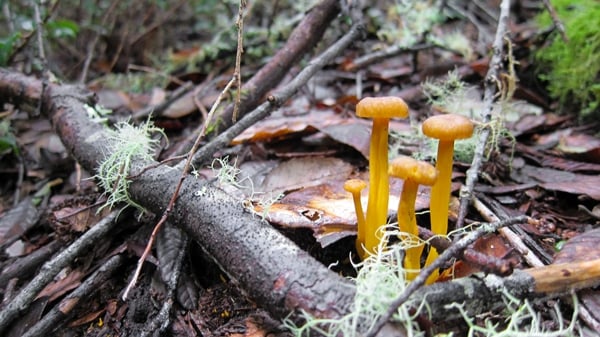
The alarm shocked me out of a dead sleep; I’d been dreaming of geese, and could still hear them ringing in my ears as I looked at the clock. Ugh. 4:21 a.m.
As early as it was, I would have needed to wake up an hour ago if I were really hunting geese. But I would be leaving my shotgun at home this morning. Nope, today I’d be bringing just a knife – and a huge stack of little wax bags stuffed into my knapsack. Today was for mushrooms.
And not just any mushroom. I was hauling myself out of bed at such an ungodly hour in search of Craterellus tubaefomis, better known as the yellowfoot chanterelle. It’s not the sexiest wild mushroom around – it’s not even the most prized of the chanterelles — but the humble yellowfoot is one of the secrets to my cooking, an ingredient I must have in my pantry.
Quietly, I put yellowfoot chanterelles in everything. Stocks, broths and consommés, stews, soups, braises and stuffing. The yellowfoot is to me what regular button mushrooms are to the rest of America. It is my staple.
That means I need a lot of them. And you can’t find yellowfoot chanterelles near where I live in Sacramento. They live up north, on California’s forbidding North Coast. Groggy still from my goose dreams, I made myself a thermos of black coffee and gathered my gear: knapsack, wax bags, mushroom knife, granola bars, a few tangerines, and my field guide, David Arora’s All That the Rain Promises and More. I laced up my boots, pet my cats and headed into the predawn gloom.
Even at 5 a.m. there is traffic on the highways leading into San Francisco. But I soon left the main roads and worked my way toward the Pacific. California’s North Coast is a classic example of “you can’t get there from here.” The residents have, for generations, resisted attempts to build wide highways to the sea, so a trip of only 165 miles can take more than four hours.
I hit the legendary Shoreline Highway, California’s Highway 1, at dawn in Bodega Bay. From there it is nearly an hour north along one of the nastiest, twistiest, gut-sloshingest stretches of road in the United States.
Hairpin turns along sheer cliffs that drop hundreds of feet into an angry sea (the Pacific Ocean is horribly misnamed) make for some interesting driving. No part of America’s coast is quite like this: Grim, rocky coasts. A palisade of high cliffs. Mammoth redwood forests growing right up to the edge of the sea. Abalone in the tidepools. Sea lions on the matted boulders, and the Man in the Gray Suit, the great white shark, lurking beyond, unseen.
Even with the white-knuckle driving, I managed to catch glimpses of the plants lining the side of the road. Cow parsnip already growing in earnest; it’s a great cooking green, especially when mixed with mashed potatoes in the style of Irish colcannon. Among the parsnip were skeletons of last year’s wild fennel, standing like aspens in December, barren and forlorn. Underneath them grew tufts of this year’s fennel, sweet and fresh and awaiting warmer days.
As the sun rose I passed the mouth of the Russian River, which in September can be choked with king salmon. Now its flow was so stunted a sandbar blocked the river’s path to the sea. A flock of gulls pecked at what should have been its mouth. Even the river waits for spring and snowmelt.
Ahead lay the promised land: Salt Point State Park. It is a rare day that a mushroom hunter will reveal his secret spots, but Salt Point is no secret. The park is probably the most well-known place to pick mushrooms in California, if not all of the West Coast. And despite heavy pressure, mushrooming at Salt Point is more like picking and less like hunting. A strict five-pound per person limit and energetic park rangers are only part of the reason. Some mysterious combination of soil, moisture and plant life makes the place a mycologist’s dream and a picker’s heaven.
I found a quiet place to park my pickup along Highway 1, grabbed my pack and headed into the woods. I glanced at my cell phone: “No Service.” Damn. It’s an occupational hazard of living a wild life. Where I spend most of my time, cell phone reception is a happy accident more often than not. Losing my easy connection to the outside world heightened my already active awareness that what I was doing was slightly dangerous. Hiking off trail solo, even in a state park, can end in disaster. A fall, a broken bone, an animal attack – I saw so much evidence of wild boar rooting in the forest the duff looked like it had been roto-tilled – anything could happen.
What’s worse, this part of California is in the infamous Emerald Triangle, where big-time drug cartels have hidden marijuana-growing plantations. Some are in state parks, and mushroom hunters encounter them with some frequency. My friend Eric, who I’d hunted with in this area of Salt Point several times before, has noted casually that this was the section of forest where he’d been jumped by state police wearing full camo and armed with AR-15 assault rifles. They’d been looking for drug dealers when they found Eric. He’d been looking for black trumpet mushrooms when they popped out from behind a deadfall and shouted at him. “What are you doing here?” Rattled, Eric blurted out: “Looking for mushrooms!” Immediately realizing that these were anti-drug agents, he quickly added: “EDIBLE mushrooms!” They sent him back to his truck a little shaken.
So as I hiked up into the hills, I bent down and grabbed a worthy-looking stick. A club against an armed drug dealer would probably be worse than useless, but it made me feel better. And I could probably fend off an angry wild boar with it. Or at least that’s what I told myself.
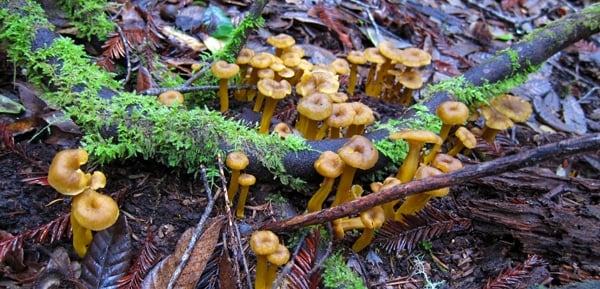
I wandered for an hour before I spotted my first patch of yellowfeet. Craterellus tubaeformis is actually something of a composite species, with several closely-related variations that occur in cold, coniferous forests across the northern part of the planet; California is just about the farthest south these mushrooms appear, which is why we enjoy them as a winter mushroom.
I find them associated with Douglas fir and other conifers, but the general mycological opinion is starting to swing from classifying yellowfeet as a mycorrhizal fungi – one that lives with particular trees – to one that decomposes dead plant matter, a saprobe. My general rule is to look in open conifer woods where there are a fair amount of downed logs or branches and a good layer of pine duff. Moss is another good sign, and the kicker, at least on California’s North Coast, is the presence of all these things plus a tufty grass I’ve not yet been able to identify.
That’s where I found my first patch. But alas, another picker had been there before me. Broken stems stood all around me, and most of the pristine mushrooms were small. But yellowfeet grow so fast that about a third of the patch was harvestable; I was picking on a Wednesday, so my predecessor must have been there over the weekend. I dropped to my knees, set down my makeshift club and started picking. It’s always important to watch your step when you are in yellowfoot country: You might be stepping on them without knowing it.
I worked carefully and methodically, pinching off the mushrooms with my fingernails and popping them into a wax bag. Wax bags, incidentally, preserve the mushrooms better than paper, and far better than plastic, which prevents the moisture-laden mushrooms from breathing and will often disintegrate them before you even get home.
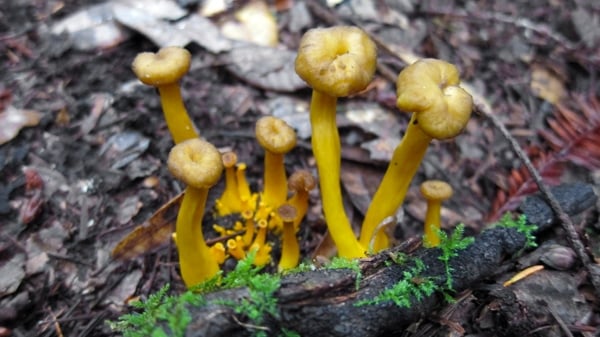
I stood up with just about a bag of mushrooms, about a half pound. Not bad, but I had a long way to go to fill my five-pound limit. I hiked on.
A few more hours, and I’d collected a couple candy cap mushrooms, which taste like maple syrup, as well as a few stray hedgehogs, which taste like chanterelles. But no more yellowfeet. I decided to move. This time I drove to a spot I could see from the road: Lots of pines and a seemingly open forest. I hiked uphill no more than 200 yards when I saw it: A swath of yellowfoot chanterelles the size of my living room. They were everywhere. A motherlode.
I dropped my stick, whipped out my wax bags and began picking with abandon – as if the mushrooms would disappear if I hesitated. Within minutes I’d filled a bag. Then another. A herd of angry boars or the entire Mexican drug cartel could have been storming down that hill for all I cared. All I wanted, all I could see were these pretty little mushrooms. It was lust.

A yellowfoot is easy to love. They are petite, with caps no more than three or four inches across, and mostly far smaller than that. They are usually clean, especially if you snip them off at the base with your fingernails or scissors. Yellowfoot caps are a tawny brown with a cute little dimple in the center, and their stalks – their feet – are a fetching canary yellow.
As it happened, I’d walked into an entire hillside of yellowfeet. I spent the next three hours picking, so long it almost felt like work. Almost. In the end I had to stop: I had my legal limit of five pounds, about $200 worth in a specialty market. Everything in me told me to break the law, to pick just one more bag. No one would notice… But reason won. Why risk a ticket and having the ranger confiscate all my mushrooms for just another pound? Besides, I could come back tomorrow.
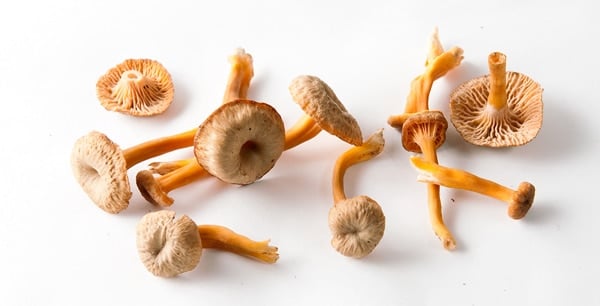
In the kitchen, yellowfoot chanterelles are even more versatile than their more glamorous cousins, the true chanterelles. Real chanties cannot be dried, in my opinion; they lose their aroma and get unpleasantly leathery. Real chanterelles are best pickled. Yellowfoot chanterelles are just as good as a pickle, and their petite size makes them prettier on the plate. What’s more, yellowfeet are wonderful dried, which is important: I use them constantly in my cooking.
I highlight yellowfeet in this Russian-style goose stew, and in this mushroom recipe dedicated to Salt Point. For further ideas, look to France and Scandinavia for your inspiration.
Identifying a yellowfoot is not hard. Start with location: They will be in damp, cool woods in the North. I’ve found them in New England in October, and they are a late summer mushroom in Scandinavia. I never really see them in California until December, and they can stick around until February or even March in some years. You will never see just one yellowfoot; they only fruit in troops.
Now key in on the height of the mushroom, which is really no more than about 4 inches. Next go to the color: In the West, they are a beautifully warm gold, with that tawny cap. In the East they are a little more brownish. The cap, even when large, will not be too much larger than a quarter.
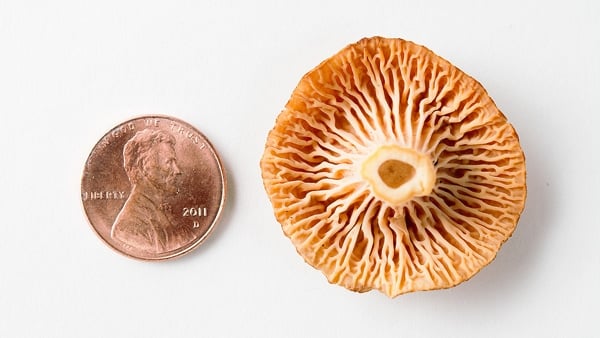
Note the “gills.” Like all chanterelles, these are not actually gills. They are more like folds under the cap. Keep an eye out for this, as there are a few mushrooms that kinda-sorta look like yellowfeet that have real gills.
Anther key thing about yellowfoot chanterelles is that they are hollow; thus the Latin name tubaeformis. You should be able to use them as a drinking straw, if you were so inclined.
Their hollowness also allows yellowfeet to be easily cleaned. If you snip them off at the base to avoid dirt, and then pull them in two, you will get all the dirt out of them in a snap. A quick rinse in cold water, followed by a rest on a clean towel will do the trick. Don’t clean your mushrooms until you plan on eating or drying them, however.
Can you buy yellowfoot chanterelles? Yes, if you are lucky. I’ve seen them at high-end markets such as Whole Foods, but I’ve never seen a source of them dried. Buy them if you see them.
But as this is one of the easier mushrooms to identify, go out and look for some if you live in the North. And remember the spot: They will return year after year.
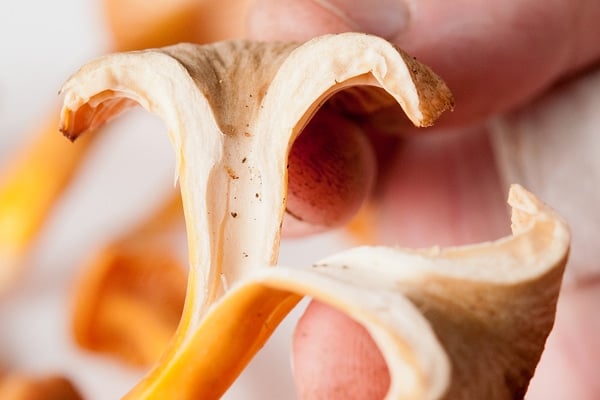
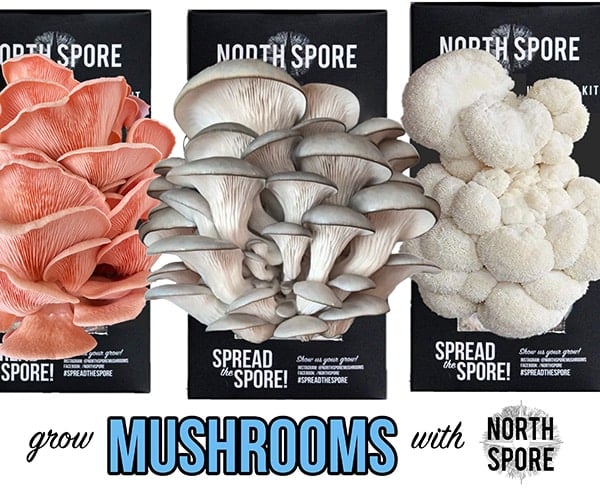
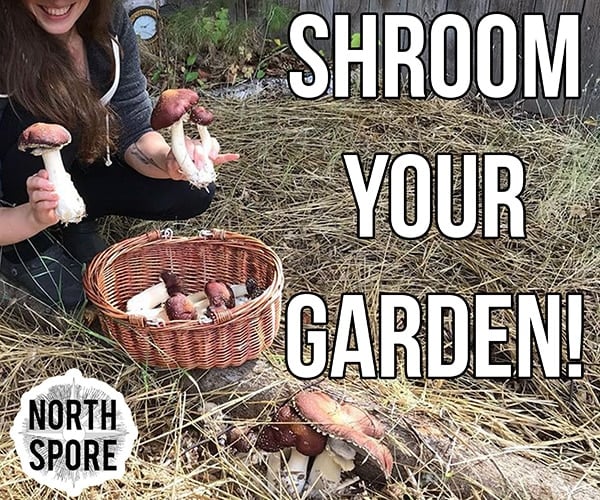



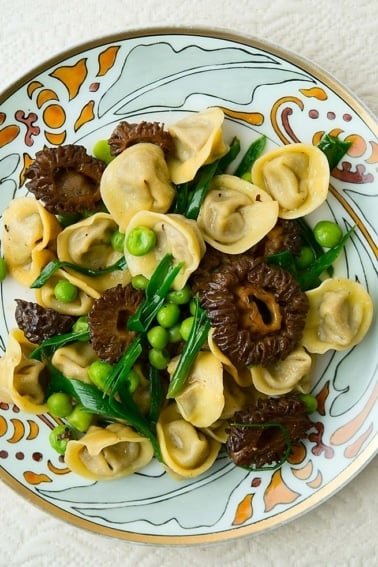
Sorry Hank: 1 more, if I may
How do you know when you have 5 lbs? How do the rangers know? Do they weigh your bucket? And how do you know when you are about to go over?
-Lou
Forgot the “?”.
Duh Lou, you man-dope 😮
Hank,
Poisonous look-a-likes (sorry if the question was already asked)
-Lou
One more vote for “half cooking” then freezing golden chanterelles. It works perfectly. I usually sauté them in a little olive oil and minced garlic until some of the water is out, but well before they are fully cooked, and then freeze them in ziplocs. But chanterelles are the only mushroom I store that way. I prefer to dry morels and porcini.
Paper bags are just as good as waxies. Brown waxies are better than the plain ones…they hold up far better in the damp and rain.
If you live in the Bay Area, there are lots of places to buy waxies: Berkeley Bowl, Whole Foods, Piedmont Grocery, etc. etc. Any higher end grocery.
Yup, a quick sautee and then freezing is a great way to preserve golden chanterelles…but you need a big freezer, and one that doesn’t spontaneously defrost itself, like mine does!
Another way to deal with wretched golden chanterelle excess (prob. NOT gonna happen this year) is chanterelle bacon. Chop fairly finely, then throw into a hot wok; when the mushrooms stop bubbling, they are ready to take out. They become crisp and dried and concentrated and resemble bacon bits, but with a delicious difference. You can then store them in the freezer and remove as needed. Plus, you can feed them to your vegan friends, without guilt.
God knows I missed bacon when I was a vegetarian, for a couple of years in my late teens.
Mmmmmmmm, bacon.
Great post, Hank. Yellowfoot are definitely way underrated by most pickers.
As for golden chanterelles being best preserved as a pickle- have you ever tried sauteing the water out of them, then vacuum bagging and freezing? That is my preferred method of preservation for chanterelles and most other mushrooms. I have frozen bags of chanterelles, porcini, morels, black trumpets, agaricus augustus, etc all with great results. I’ve used chanterelles that were over a year old preserved in this way with only a small loss in quality over fresh. You might consider giving it a try next time you’ve got a load of chanties.
Thanks for sharing your secret recipe Hank!
Thanks for the link to the bags Hank. I can see many uses for them.
Those little mushrooms look very familiar; I’ll pay more attention this year (Massachusetts) and try to identify them (and maybe eat them!).
I’m a little surprised that wax paper bags are better than brown paper…aren’t the wax paper bags as air-proof as plastic bags? I use wax paper all the time for packed lunches.
Hank, try using little scissors instead of pinching. Faster, cleaner, prettier! You are probably still in range. Good morning!
They have poundage limits for mushrooms in CA? That is too bad. Here in Cordova the yellowfoots are out of control. After about an hour walking in the woods it is not hard to fill several grocery bags up.
Do you have any good recipes for hedgehogs?
Sarah: Buy David Arora’s “All that the Rain Promises and More.”
https://www.amazon.com/All-That-Rain-Promises-More/dp/0898153883/ref=sr_1_1?s=books&ie=UTF8&qid=1357408165&sr=1-1&keywords=all+the+rain+promises+and+more+the+field+guide
Debbie: Nope, never seen evidence of a grow in SP, thank God! And I will be up there tomorrow, actually…
Hey Hank,
Well, there goes the neighborhood! Usta be these tasty little shrooms were ignored by the majority of Salt Point pot-hunters, but maybe not so much anymore!
Yellow feet are indeed delicious and with a great texture, and they will rehydrate just like fresh! My husband David makes a fabulous dish with these, in a marsala sauce over grilled scallops. Yum!
These mushrooms are also unusual in that they can often be found growing on wood: well-rotted wood. They also like nice wet zones for fruiting.
Perhaps they, like some of the more primitive amanita species, have retained the ability to break down wood like a saprobe? All we need is a lab and someone willing to do the enzyme assays to prove or disprove this theory!
But enough intellectualizing. Guess it’s about time to head up the coast meself.
Debbie Viess
ps you mean all of the cops in camo in our woods are actually looking for pot growers? that’s a relief. I thought that they were there to bust mushroom hunters over their limit. it’s way safer for them to just concentrate on fungal scofflaws, though, which may be why the majority of “busts” along the coast seem to be mushroom not pot related. Pocket knife vs AR15? No contest.
I have NEVER seen evidence of a grow site at SP, have you? Pig sign, human sign, sure.
Finding loads here on the Oregon coast near Newport. What a great winter mushroom!
Loved your story. I am determined to forage for mushrooms this spring/summer/fall. It is likely a long drive from here to Cypress Hills because most of the local land is very dry. Can you recommend a good book for a neophyte mushroom hunter?
Ray: I get them online. Here is a link to what I use:
https://www.amazon.com/Natural-Value-Waxed-Paper-Bags/dp/B001KUSK5G/ref=sr_1_3?ie=UTF8&qid=1357331616&sr=8-3&keywords=wax+sandwich+bags
This may push me over the edge. Never gathered a mushroom even though I grew up in Santa Cruz! This sounds abundant, identifiable, and tasty. Perfect for a first time mushroom hunter. Thank you.
I so enjoyed reading this… mushroom fever has definitely hit. I keep striking out down here and its mighty frustrating.
Great Post! Enjoyed your writing and descriptions. Such pretty little yellow foots! Remember finding them with you this past October on Cape Ann! Will definitely look in same place this October! Enjoy!
Nice article, thanks. Where do you get the wax bags you mention?